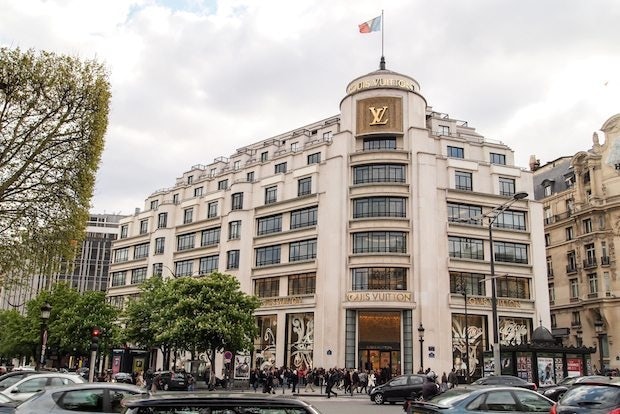
Louis Vuitton's store in Paris. (Shutterstock)
Thanks to a weaker euro and Chinese shoppers’ growing fascination with international travel, they’ve been on a global luxury buying spree with skyrocketing spending growth rates.
According to recent numbers released by VAT refund company Global Blue, Chinese spending on luxury goods shot up 122 percent in March, a staggering increase that has been on the rise since last year. Previously hitting 52 percent in February, the total growth rate for the first quarter of 2015 was 67 percent. In 2014, it saw 32 percent growth in the fourth quarter that contributed to an overall 18 percent growth rate for 2014.
The sharp upturn in spending is due to several key factors, with the most obvious being the widened price gap between luxury goods in mainland China and Europe thanks to the weakening euro. While the high “China price” of luxury goods has been driving shoppers abroad for years—experts estimate that between 70 and 76 percent of luxury goods purchased by Chinese consumers are bought outside the mainland—recent currency fluctuations have meant that some items can be 70 percent more expensive in China than in Europe. Some brands have taken extreme measures to address the issue: Chanel, Tag Heuer, Cartier, and Patek Phillippe have lowered their China prices, while Burberry is considering the same policy.
The soaring growth isn’t necessarily all good for luxury brands. While many of these sales are likely thanks to price-savvy Chinese tourists buying for themselves, friends, or family, a significant proportion is also likely going to gray-market daigou sellers who plan to smuggle the goods past customs and list on Taobao or WeChat. Although the gray market still boosts short-term sales for brands, it has many downsides—unauthorized sellers may hurt brand perception, and quality after-sales service isn’t available to buyers. In addition, many online shops purporting to be selling genuine daigou goods are actually just hawking very expensive fakes.
Another big cause for the rise of international sales is the decline of Hong Kong as a luxury shopping destination for mainlanders in the wake of political upheaval and anti-mainland protests at popular shopping centers. While it’s convenient for mainlanders to travel to Hong Kong to shop, many who wish to stay within Asia are increasingly willing to head to South Korea and Japan to avoid disruptions and seek lower prices, while experienced travelers are venturing further afield to the United States and Europe—especially now that the euro is creating such favorable prices. Recent travel restrictions on visitors from Shenzhen aimed at combatting the gray market are likely to exacerbate this trend.
It's not just the major price difference that has Chinese travelers shopping abroad at growing rates, however. Many also prefer the service quality and selection of international stores—not to mention the authenticity factor of buying a French or Italian brand in Paris or Rome market and the “face” it brings them to give quality gifts to their family and friends from their travels. The key for luxury brands will be to strike a balance between encouraging growth from these types of customers and discouraging gray market sales on the mainland.